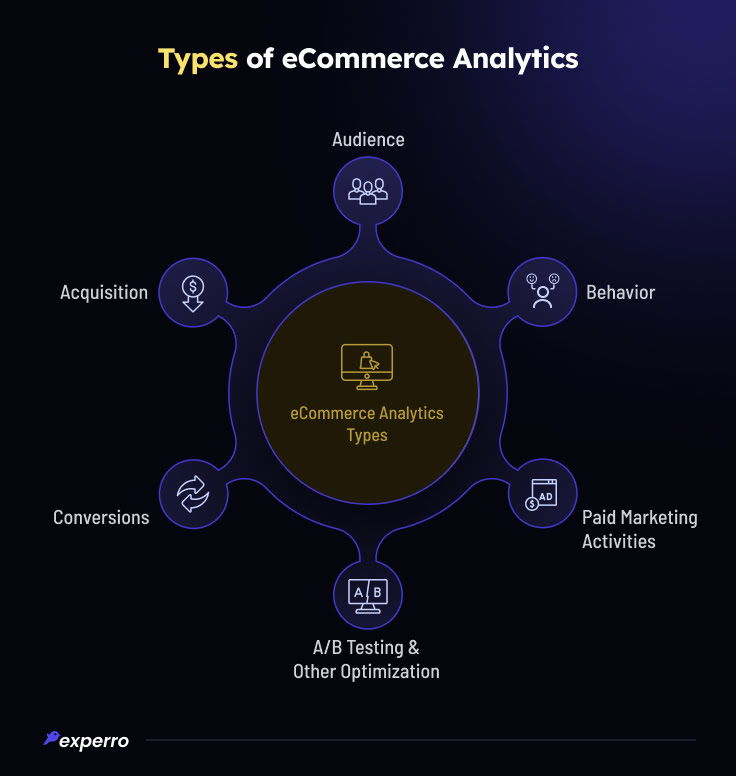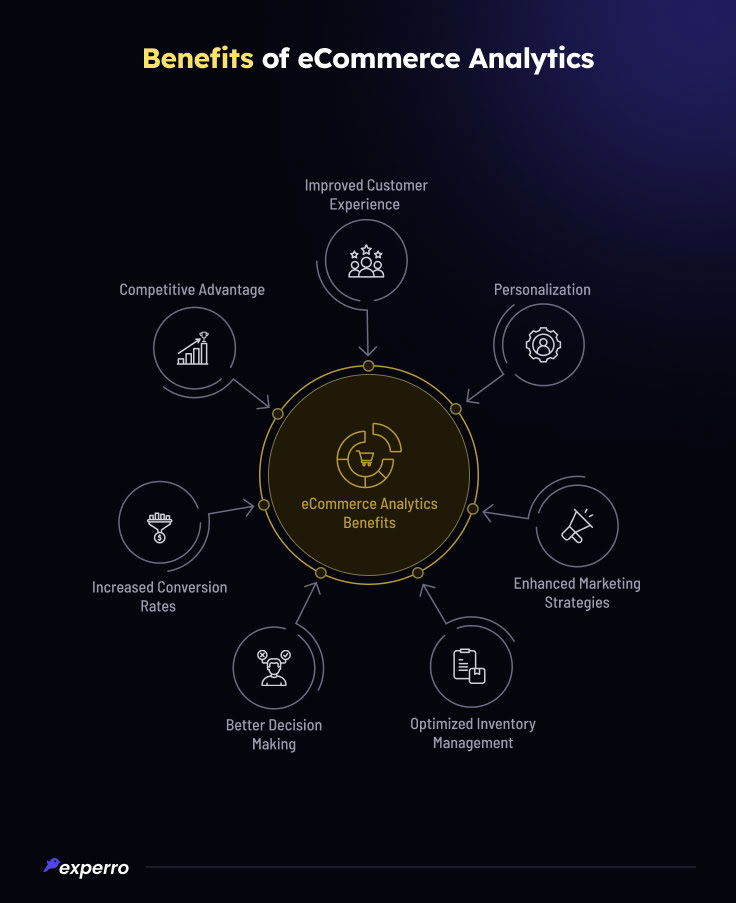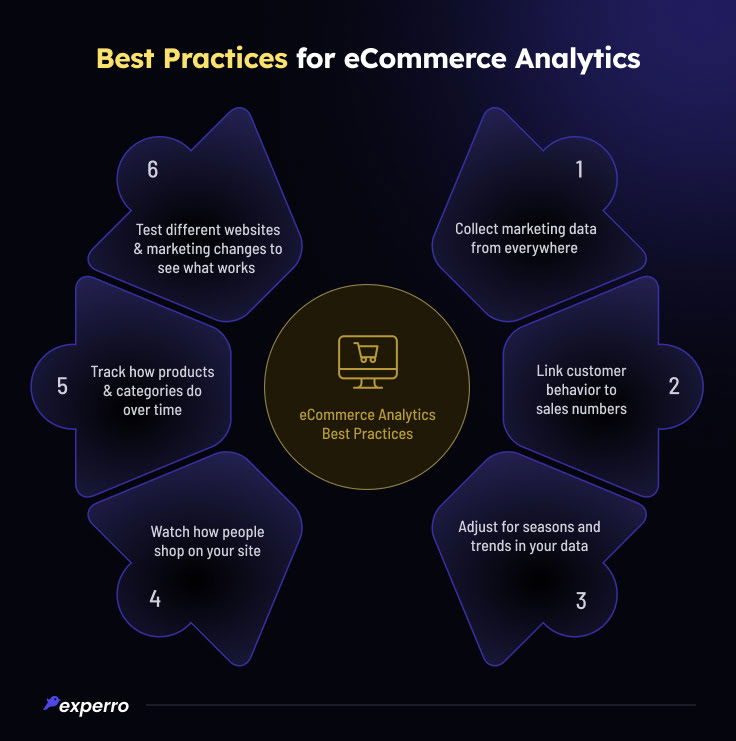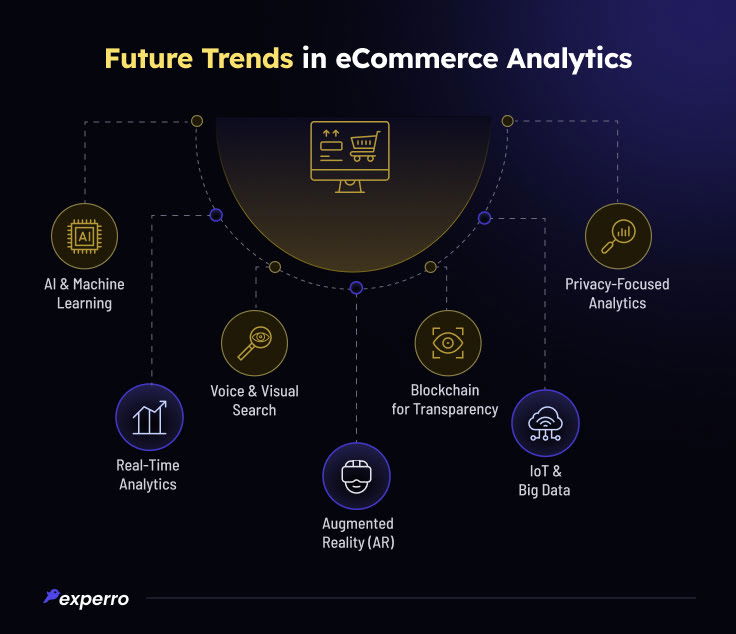eCommerce Analytics Guide for 2024: Boost Your Online Sales

What’s Inside
- What Is eCommerce Analytics?
- What Is the Importance of eCommerce Analytics Tools for Online Businesses?
- What To Do with Your Ecommerce Analytics Data?
- What Are the Types of eCommerce Analytics?
- What Are the Core eCommerce Metrics and KPIs?
- 6 Benefits of Utilizing Analytics for eCommerce Business
- What Are the Common Challenges/Solutions in eCommerce Analytics?
- 6 Best Practices for eCommerce Analysis
- Why Is Experro the Best Platform for eCommerce Analysis?
- Ready to drive growth in your eCommerce business?
- What Are the Future Trends in eCommerce Analytics?
- Experience the power of advanced eCommerce analytics with Experro today!
- Conclusion
key takeaways
- Leveraging eCommerce analytics is essential for optimizing inventory, personalizing customer experiences, and enhancing marketing strategies.
- Real-time data analysis in AI and ML integration are vital trends. They are shaping the future of eCommerce analytics.
- Effective use of analytics tools can significantly improve decision-making and increase conversion rates.
- Privacy and data security remain paramount for businesses. They navigate the complexities of collecting and analyzing consumer data in compliance with global regulations.
- Experro is an ideal choice as it offers AI-powered search and personalized product discovery for eCommerce analytics.
This year, for the first time, online shopping sales will hit over $6 trillion. Even though growth is slowing down, we're heading towards spending more than $7 trillion by 2025.
However, this growth also means the battle for customers' attention will get more competitive.
For eCommerce store owners, staying ahead of the curve isn't just a goal—it's a necessity.
And guess what?
Leveraging data analytics is a surefire strategy to boost your sales and stand out. This way, businesses can surpass customer expectations, becoming the top choice for shoppers.
Before we explore more, let's break down what eCommerce analytics is and why it's crucial for your brand's success.
What Is eCommerce Analytics?
eCommerce analytics is the process of using data to understand how your online store is performing. Think of it as a deep dive into everything happening on your site, from how many people visit it to what they end up buying.
Analytics for eCommerce helps you track, report, and analyze data collected from your online business.
eCommerce analysis goes beyond counting visitors; it investigates every interaction customers have with your site.
Data analytics for eCommerce can help you get a clear picture of your customers' behavior. This includes which products they're interested in, how they navigate through your site, and what makes them decide to buy something (or not).
What Is the Importance of eCommerce Analytics Tools for Online Businesses?
As we move into digital experiences, consumers expect more from brands, and the eCommerce world is buzzing with activity.
Global eCommerce revenue is expected to hit $1.4 trillion by 2027, with an annual growth rate of 11.22%.
That’s why eCommerce performance analytics is required, as it tells you what's working well and what needs improvement.
Web analytics for eCommerce focuses specifically on how users interact with your website. It provides insights into page views, bounce rates, and conversion paths. This helps in optimizing the user experience to boost sales.
eCommerce data analysis and business analysis are about turning raw data into actionable insights. It involves looking closely at sales trends, customer retention rates, etc. This way, you can make informed decisions to grow your business.
What To Do with Your Ecommerce Analytics Data?
Using eCommerce analytics helps you understand your online shop better. It shows which products are popular and how people move around your site.
This helps you:
- Use eCommerce performance analytics to measure how well your store is doing. Look at sales trends, customer behavior, and website performance.
- Apply data analysis in eCommerce to personalize marketing efforts. It ensures you reach the right audience with the right message.
- Leverage web analytics eCommerce tools to understand how visitors interact with your site. This can help you optimize your website layout and improve the shopping experience.
- Conduct eCommerce analysis to identify which products are your best sellers and which aren't performing well. It allows you to adjust your inventory accordingly.
- Implement advanced eCommerce analytics to forecast future trends. It helps you stay ahead of the competition.
Remember, eCommerce analytics best practices involve continuous monitoring and analyzing your data. Whether you're just starting or looking to enhance your data-driven decisions, investing in the right eCommerce analytics tool is crucial for success.
What Are the Types of eCommerce Analytics?
eCommerce analytics plays an essential role in understanding and optimizing the online shopping experience.

Let's dive into its types and how they impact your online business:
1. Customer Data Analytics
This focuses on who your visitors are. This includes demographic details, interests, and behavior patterns. Understanding your audience through eCommerce analytics is key to tailoring your content and offerings.
2. Acquisition Analytics
Acquisition analytics examine how customers find your online store, through search engines, social media, or referrals. eCommerce website analytics tools can track the effectiveness of acquisition strategies.
3. Behavior Analytics
Behavior analytics sheds light on the customer journey by analyzing how users interact with your site. From the pages they visit to how long they stay; eCommerce website analytics offer insights into customer engagement and preferences.
This aids in website optimization for an enhanced user experience.
4. Conversion Analytics
The goal here is to understand what leads to sales and what doesn't. eCommerce performance analytics measure critical conversion paths, highlighting opportunities for optimization.
5. Paid Marketing Activities Analytics
eCommerce marketing analytics assess the ROI of advertising campaigns. Analytics tools for eCommerce can pinpoint which channels and messages drive the best results.
6. A/B Testing and Other Optimization Analytics
Through A/B testing, businesses can make data-driven changes to their websites. Many eCommerce analytics tools allow comparing different website versions to improve user experience and conversions.
Now, let’s delve deeper into the key metrics and KPIs essential for monitoring and enhancing your eCommerce performance.
What Are the Core eCommerce Metrics and KPIs?
This strategic approach to eCommerce analysis enables data-driven decision-making. It also fosters growth and competitive advantage from marketing and sales to inventory and customer service.
Let's discuss its key metrics and KPIs:

Sales Metrics
1. Sales Conversion Rate
The sales conversion rate is an important metric in eCommerce analysis, representing the percentage of visitors who purchase.
To calculate, divide the number of sales by the total number of visitors and multiply by 100. Industry benchmarks vary, but a reasonable conversion rate generally falls between 1% and 3%.
It directly reflects your website's effectiveness in turning visitors into buyers. This makes it a top priority in analytics for eCommerce.
2. Average Order Value (AOV)
Boosting your AOV is a strategy smartly employed by many eCommerce analytics companies. By promoting add-on products and related items, businesses can get customers to spend more on each purchase.
Implementing personalized product recommendations is a practical strategy to elevate AOV. Offering exclusive bundle deals is another practical approach to increase average order value.
3. Customer Lifetime Value (CLV)
Enhancing CLV is fundamental in eCommerce performance analytics. Implement retention strategies to increase the total value a customer contributes throughout their engagement with the brand.
These strategies include personalized marketing, loyalty programs, and exceptional customer service. Monitoring CLV helps in allocating market spending more efficiently.
Customer Metrics
1. Customer Acquisition Cost (CAC)
Balancing CAC with CLV is essential for profitability. This balance underscores the importance of eCommerce business analysis.
This also ensures that the cost of acquiring a new customer does not outweigh the value they bring. Reducing customer acquisition costs through more effective marketing channels and improving conversion rates are key strategies for eCommerce analysis.
2. Returning Customer Rate
A high return customer rate is crucial for eCommerce sustainability. It indicates user satisfaction and loyalty.
This also reflects the effectiveness of retention strategies and the overall health of your customer relationship management.
3. Churn Rate
Reducing churn and enhancing customer loyalty are core focuses of eCommerce marketing analytics. Implementing feedback loops, improving customer service, and offering personalized experiences can help decrease churn rates.
Consumers expect personalized offers and 56% of shoppers want to be treated as individuals by companies. It also secures a loyal customer base essential for long-term success.
Website and Marketing Metrics
1. Shopping Cart Abandonment Rate
Ever wondered how important checkout optimization is in eCommerce web analytics?
Well, it's crucial!
But, cart abandonment is a challenge that affects all businesses with an average abandonment rate of 70%.
Streamlining the checkout process and offering multiple payment options can significantly lower this rate. Reassuring customers with security badges also directly impact sales performance.
2. Bounce Rate
Bounce rate tracks the percentage of visitors who leave after viewing only one page, offering insights into engagement and content relevance.
A high bounce rate suggests areas for improvement in website design, content, and user experience to encourage deeper interaction and satisfaction. eCommerce website analytics helps you to analyze bounce rates by traffic source and can further refine marketing and optimization strategies.
3. Net Promoter Score (NPS)
NPS is leveraged to measure customer satisfaction and collect feedback for improvements.
A high NPS indicates a healthy customer base willing to promote your brand, an invaluable asset in competitive markets.
4. Click-Through Rate (CTR)
The study finds that the average customer CTR drops significantly after position one. Positions two and three have a click-through rate of 15% and 11%, respectively.
Enhancing CTR involves optimizing content and ads. eCommerce analysis often emphasizes this for driving traffic and improving engagement.
Analyzing CTR by channel helps refine targeting strategies and ad copy for better performance.
Advanced eCommerce Analytics
1. Impressions and Reach
Differentiating between impressions and reach is necessary for effective marketing. Understanding these metrics can help eCommerce businesses optimize their visibility and engagement strategies on various platforms.
2. Engagement Metrics
Engagement metrics serve as indicators of content relevance and data quality. It is crucial for analytics in eCommerce to understand customer interests and preferences.
Tracking engagement can inform content marketing strategy, product development, and marketing approaches.
3. Store Sessions Analysis
Insights from analyzing traffic sources, device usage, and geographical data are key in data analysis in eCommerce.
It helps businesses tailor their strategies to target audiences effectively. This analysis can reveal hidden opportunities and areas for optimization.
4. Product Performance
Managing inventory and optimizing product offerings based on sales data are best practices in eCommerce analytics.
It ensures that businesses can meet customer demand efficiently. Tracking product performance aids in decision-making regarding promotions, discontinuations, and inventory management.
By focusing on these core metrics, businesses can gain valuable insights into their operations, customer behavior, and market trends. Leveraging the right eCommerce analytics tools is essential in achieving this understanding.
6 Benefits of Utilizing Analytics for eCommerce Business
In the fast-paced world of online retail, using eCommerce analytics is no longer optional—it's essential for eCommerce success. These tools provide important insights that can transform how businesses operate.
Best eCommerce SEO platforms make them more customer-centric, efficient, and competitive. Here's how analytics for eCommerce can drive significant improvements across various aspects of your business.

1. Improved Customer Experience and Personalization
eCommerce analytics play a crucial role in tailoring the best customer experience for each shopper. eCommerce businesses can personalize product recommendations and marketing messages by analyzing behavior and preferences.
This makes shopping more relevant and enjoyable. Data analysis ensures that customers find what they're looking for faster. It also leads to a more satisfying shopping experience.
2. Enhanced Marketing Strategies
Companies can fine-tune their advertising efforts for better reach and engagement with eCommerce marketing analytics. Analyzing search engine marketing and email campaigns helps in allocating the budget wisely.
Through marketing strategies, businesses can also analyze the effectiveness of their marketing campaigns across various channels such as social media, various email marketing campaigns, and PPC.
This ensures that every penny spent contributes to a higher return on investment (ROI). eCommerce analysis tools enable businesses to track the effectiveness of various marketing channels. This also helps you in optimizing strategies in real-time.
3. Optimized Inventory Management
Analytics in eCommerce helps you analyze which products are selling well and which aren't. Inventory management also helps maintain perfect stock levels, reducing overstock and understock situations.
This level of inventory optimization can significantly reduce costs and improve customer satisfaction by ensuring popular items are always available.
4. Better Decision Making
Ever faced problems while making decisions for your eCommerce platform?
Data analytics in eCommerce equip decision-makers with the information needed to make informed choices.
Whether it's about launching a new product or entering a new market, eCommerce analysis offers a data-backed roadmap. This can reveal new opportunities for growth and help avoid potential pitfalls.
5. Increased Conversion Rates
By understanding the customer journey through website analytics, businesses can identify and fix any hurdles in the buying process.
Web analytics for eCommerce help optimize the site layout, speed, and checkout process to boost conversions. This direct approach to addressing customer experience issues can significantly improve sales figures.
6. Competitive Advantage
Advanced eCommerce analytics allow for the anticipation of market trends, a better understanding of customer needs, and the agile adaptation of strategies.
eCommerce analytics platforms and various companies provide the tools and expertise needed to leverage this competitive edge.
What Are the Common Challenges/Solutions in eCommerce Analytics?
Navigating the complexities of eCommerce analytics can be challenging. Businesses can overcome these hurdles to harness the full power of their data with the right strategies and solutions.
1. Data Overload and Silos
Challenge: Collecting vast amounts of data analytics from different sources can lead to information overload and data being stored in isolated systems. This makes it hard to get a unified view of performance.
Solution: Implementing an integrated eCommerce analytics platform helps consolidate data across all channels. This unified approach to analytics in eCommerce simplifies data points and analysis.
2. Real-Time Data and Accuracy
Challenge: Obtaining up-to-date, accurate data can be complex, yet it's essential for making timely decisions.
Solution: Utilizing platforms that enable real-time content previewing & editing gives businesses up-to-date insights.
Ensuring data accuracy becomes simpler with data analysis practices that validate data regularly and enhance decision-making processes.
3. Tool Complexity
Challenge: The complexity of advanced eCommerce analytics software can be daunting, especially for those who need more technical expertise.
Solution: Choosing eCommerce analytics software known for its user-friendly interface makes complex data more accessible.
Alternatively, investing in staff training can also help utilize complex data effectively. Some eCommerce analytics tools are designed with simplicity without sacrificing the depth of analysis.
4. Actionable Insights
Challenge: Turning raw data into actionable insights is often easier said than done.
Solution: eCommerce business analysis should translate data into clear action points. Utilizing analytics tools for eCommerce that provide intuitive dashboards makes data more accessible.
This accessibility helps bridge the data collection and strategic action gap with actionable reports.
5. Privacy and Security
Challenge: Collecting and storing sensitive customer data raises significant privacy and security concerns.
Solution: Following the best practices for data security and privacy is essential, such as sticking to GDPR (General Data Protection Regulation) and CCPA (Central Consumer Protection Authority) rules. Using eCommerce analytics software that prioritizes data protection helps safeguard customer data.
Businesses can leverage analytics by addressing these common eCommerce challenges with strategic solutions. This supports driving growth, improving customer experiences, and maintaining a competitive edge in the digital marketplace.
6 Best Practices for eCommerce Analysis
Below are six best practices that help you use your data smartly to grow your business and beat the competition.

1. Collect Marketing Data from Everywhere
Use eCommerce analytics tools to gather information across all your marketing channels. This ensures you take advantage of valuable insights that could drive your strategy.
2. Link Customer Behavior to Sales Numbers
Analytics for eCommerce help you understand how customer actions directly impact your sales. By correlating this data, you can pinpoint what drives purchases and focus on those areas.
3. Adjust for Seasons and Trends in Your Data
eCommerce data analytics are essential for recognizing patterns over time. This means adjusting your strategy based on seasonal changes or emerging trends to stay relevant and competitive.
4. Watch How People Shop on Your Site
eCommerce website analytics give you a window into the customer journey. Observing how users interact with your site can reveal improvements that increase conversions.
5. Track How Products and Categories Do Over Time
With data analytics in eCommerce, monitoring the performance of different products and categories is essential. It helps you understand consumer preferences and inventory needs.
6. Test Different Websites and Marketing Changes to See What Works
Utilizing web analytics for eCommerce allows you to A/B test various aspects of your website and marketing campaigns. This experimental approach helps identify the most effective strategies for engaging customers.
Remember, eCommerce analytics best practices are about continuously learning from your data and adapting your strategies to meet your customers' needs.
Why Is Experro the Best Platform for eCommerce Analysis?
Experro emerges as a leading platform in eCommerce analytics. It offers a comprehensive suite of features that cater specifically to the needs of eCommerce analysis.
Its approach combines advanced technological capabilities with user-centric designs. This makes it an unparalleled choice for businesses that leverage analytics in eCommerce.
Key Product Features of Experro for eCommerce Analysis:
- Headless & Composable Frontend
- AI-Powered Search & Product Discovery
- Visual Website Builder & Centralized Content Hub
- A/B Testing & Activity Dashboard
- Personalized Search Optimization
- Flexibility and Scalability
- Data-Driven Insights
- User Experience Optimization
What Are the Future Trends in eCommerce Analytics?
The future of eCommerce analytics is set to be shaped by technological advancements and evolving consumer behaviors.
Here are some detailed insights into the key trends:

1. AI and Machine Learning
These technologies are becoming increasingly sophisticated. These enable businesses to offer highly personalized shopping experiences.
Predictive customer analytics powered by AI can forecast consumer buying habits and optimize inventory management.
AI can tailor marketing messages to individual preferences, significantly enhancing customer engagement.
2. Real-Time Analytics
Analyzing data in real-time allows businesses to make quicker and more precise decisions. This immediate insight into customer behavior enables eCommerce companies to respond dynamically to trends.
Additionally, it improves customer service by allowing issues to be addressed as they occur.
3. Voice and Visual Search
As voice-activated assistants and visual search technologies become more prevalent, optimizing eCommerce platforms for these search methods becomes crucial.
This trend requires analytics tools to understand and adapt to how customers use voice and images to find products, impacting the eCommerce SEO strategy and content creation.
4. Augmented Reality (AR)
AR offers a unique way for customers to interact with products before purchasing. Analytics derived from AR experiences can provide valuable data, guiding product development and your marketing strategy.
Understanding how customers interact with virtual try-ons or product placements can drive innovations in user experience.
5. Blockchain for Transparency
Blockchain technology offers new ways to ensure data integrity and transparency, particularly in supply chain management.
This technology aids in product authentication, ensuring items are genuine. Such transparency builds trust with consumers increasingly focused on sustainability and ethical practices.
6. IoT and Big Data
Integrating Internet of Things (IoT) devices generates a wealth of data. It also offers more profound insights into user behavior data and operational efficiency.
From smart home devices to wearable technology, the data collected can help businesses understand usage patterns. It also works well to improve product offerings and personalize customer interactions.
7. Privacy-Focused Analytics
With growing concerns over data privacy and the implementation of regulations like GDPR and CCPA, businesses must adapt. They need to adopt privacy-compliant analytics practices.
This involves collecting and analyzing sales data in ways that respect consumer privacy, such as anonymization techniques and data usage transparency.
These trends underscore a shift towards more personalized, real-time, and technologically integrated approaches to eCommerce analytics.
Conclusion
Utilizing eCommerce analytics has become indispensable for online retailers in the rapidly evolving digital marketplace. It aims to optimize their operations and enhance customer experiences.
Additionally, the emphasis on privacy-focused practices transforms how businesses understand their customers. Platforms like Experro are at the forefront with their wide range of analytics features.
They offer businesses the insights to make smart decisions, personalize customer experiences, and stay competitive.
As we look to the future, the trends in eCommerce analytics promise even greater opportunities for businesses.
You can schedule a call with our team to get clarity on how our platform can help you scale your business.
Stay tuned to learn more!
FAQs


Pallavi Dadhich
09 July 2024Pallavi is an ambitious author known for her expertise in crafting compelling content across various domains. Beyond her professional pursuits, Pallavi is deeply passionate about continuous learning, often immersing herself in the latest industry trends. When not weaving words, she dedicates her time to mastering graphic design.